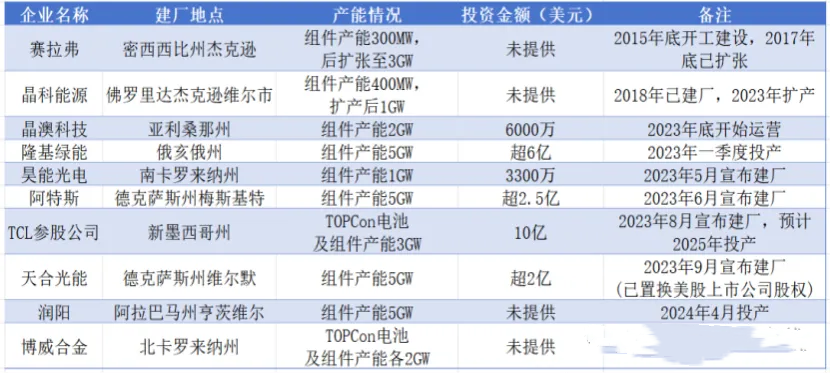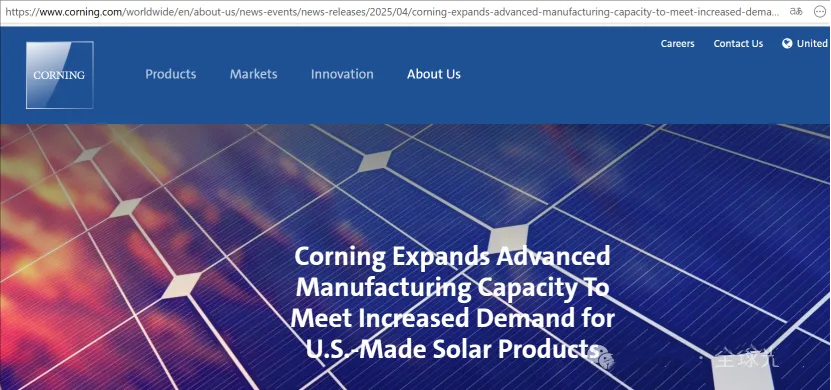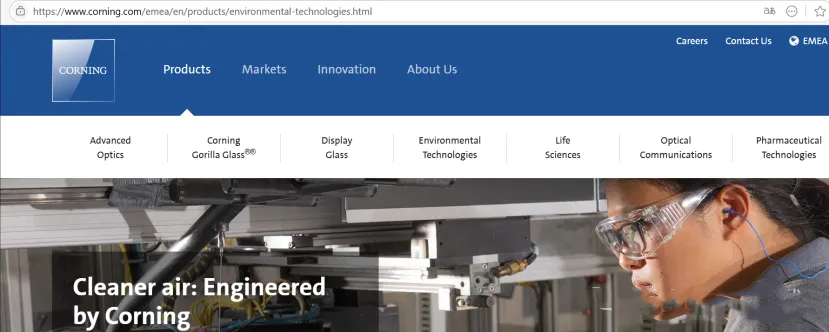Nest Egg in Danger? Another Chinese Photovoltaic Leader Withdraws United States (US) Component Production Capacity

Under Trump's administration, with actions like reciprocal tariffs, the BIG and BEAUTIFUL Act, and countervailing duty and anti-dumping investigations, China's initial response to the Biden administration's push for American manufacturing in the solar industry resulted in another withdrawal.
According to a report by PV Tech USA on July 21, JA Solar has decided to sell its 2GW module factory located in Arizona, USA, to American Panel Solutions, a wholly-owned subsidiary of Corning Inc. Therefore, this also becomes the next in line after November 2024.Trina SolarAnother leading global photovoltaic company withdrawing its manufacturing investment from the United States after selling its 5GW module factory in Texas to T1 Energy (formerly Freyr Battery).
China's leading photovoltaic company layout for manufacturing in the United States
After former U.S. President Biden took office in 2021, he introduced the IRA plan to support domestic photovoltaic manufacturing, offering subsidies of up to $369 billion to promote the clean energy industry, including domestic photovoltaic products. This policy directly promoted Chinese photovoltaic companies such as LONGi Green Energy.JA Solar TechnologyThe wave of Trina Solar, Canadian Solar, and others building factories in the United States.

In January 2023, JA Solar announced an investment of $60 million to build a high-performance photovoltaic module factory with an annual capacity of 2 GW in Phoenix, Arizona, and it is set to begin operations in the fourth quarter of 2023.
Oriental Fortune Net reported in April this year on the current status of Chinese photovoltaic companies, including JA Solar, in their U.S. factories.
In terms of production capacity: JA Solar's 2GW module capacity in Arizona, USA has been put into operation, along with LONGi, Jinko, and Canadian Solar, among others.
In terms of cost: In the first quarter, the U.S. factory incurred a loss of approximately 80 million yuan due to equipment depreciation and labor costs, with production costs being 20% higher than in Southeast Asia. Salaries for U.S. workers are 5 to 8 times those in Southeast Asia. Coupled with equipment import tariffs and environmental compliance costs, the total component cost has risen to $0.37/W.
In terms of policy, the U.S. Department of Commerce has imposed preliminary anti-dumping duties as high as 53.3% on photovoltaic modules from Vietnam and other Southeast Asian countries, forcing leading Chinese photovoltaic companies to accelerate the transfer of orders to factories in the U.S. Chinese photovoltaic companies are attempting to alleviate the pressure through the 10% local manufacturing subsidy in the IRA Act, but if the Trump administration abolishes this policy, the companies will face a higher survival threshold.
Technologically: Chinese photovoltaic companies' factories in the United States using TOPCon technology face patent litigation threats from Maxeon. If they lose, they may have to pay high compensation or adjust their technology path. Meanwhile, HJT technology is becoming popular in the U.S. market. Although JA Solar has reserved space for HJT production line upgrades, the equipment payback period will extend to 1.8 years, putting pressure on capital expenditures.
In terms of the market: Chinese photovoltaic companies plan to pass on tariff costs through price increases, but U.S. distributors are price-sensitive, and aggressive price adjustments may lead to customer loss.
By late May, the policy-related pressures analyzed above became even greater. With the introduction of Trump’s reciprocal tariff policy and discussions around the "Beautiful America Act," which targets Biden’s IRA policy, industry rumors finally surfaced that JA Solar intends to sell its US factory and shift investment to the more promising Middle Eastern market.
This rumor was finally confirmed by the American media yesterday after the "Big and Beautiful Act" dealt the final blow to the IRA Act.
Because of Biden, they built a factory in the US, and because of Trump, they withdrew investment. Trina Solar chose to exit production capacity just days after starting it the moment Trump was elected. JinkoSolar and Trina Solar have an "eight-month time difference," and the price difference between them is easy to imagine.
Currently, the U.S. photovoltaic production capacities of Longi, Jinko, and Canadian Solar are being maintained.
The emergence of "Corning Solar" in the US?
Unexpectedly, the American capacity of JA Solar was taken over by Corning, a company based in the United States that had never manufactured photovoltaic modules before.
Veteran professionals with over ten years in the photovoltaic industry may be familiar with "Dow Corning" for making frame sealants, but since "Dow Corning" was reorganized by Dow, the brand and its products have basically disappeared from the Chinese photovoltaic circle. However, suddenly, a "Corning Solar" has appeared.
On Corning's official website, there is a piece of news dated April 29 this year: "Corning expands advanced solar wafer manufacturing capacity to meet the growing demand for U.S.-made solar products and to strengthen the domestic solar supply chain with industry-leading solar manufacturers." In March 2025, Corning, Suniva, and Heliene announced the launch of the only solar module made in the United States from polysilicon, wafers, and cells all manufactured domestically.
Half a year ago, Corning was merely a polysilicon/wafer manufacturer, supplying to cell/module manufacturers like Suniva and Heliene. Half a year later, Corning acquired JA Solar's U.S. module factory, beginning its own vertically integrated industrial chain.

The reason Corning is described as having a "vertically integrated industry chain" is that just nine months ago, the U.S. Department of Commerce announced plans to provide Hemlock Semiconductor (HSC) with up to $325 million under the CHIPS Act to support Hemlock's production of silicon wafers.
The U.S. solar industry has localized component manufacturing, and overseas companies like QCELLs have started domestic battery manufacturing in the U.S. Although the upstream polysilicon manufacturing lacks competitiveness compared to Chinese companies, capacity can be restored at any time. However, in the silicon wafer sector, following the failure of the "136 Direct Wafer" method, the U.S. has completely lost manufacturing, technological, and market competitiveness.
QCELLs once invested in REC Silicon, attempting to restart REC's polysilicon production before trying wafer manufacturing. However, since REC's polysilicon quality after years of shutdown could not match current standards, QCELLs announced the shutdown of REC, after which they were sued by REC minority shareholders in court under "Stop The Steal." Another company, NorSun, once attempted to start wafer manufacturing in the United States but ultimately failed and exited.
In October 2024, the US government heavily invested in Hemlock to build solar silicon wafer capacity. Hemlock's chairman stated that the company will focus on two key industries in the future - semiconductor and solar manufacturing. Hemlock will utilize the tax credits provided by the Inflation Reduction Act and the CHIPS and Science Act to increase its participation in the solar manufacturing market. Local news also reported that besides increasing polysilicon production for the solar market, Hemlock will soon produce silicon ingots and wafers for solar panels.
Hemlock (HSC), historically renowned worldwide for its polysilicon production, is a subsidiary of Corning Incorporated. In 2016, prior to Dow Corning's business merger and restructuring with DuPont, Corning Incorporated...Dow ChemicalThe assets of its joint venture, Dow Corning, were restructured, whereby the management and operation of Hemlock, which produces polysilicon, were assigned to Corning. Although Hemlock has almost exited the photovoltaic polysilicon sector over the years, its semiconductor polysilicon capacity has remained stable in operation.
Today, Corning Incorporated has acquired a 2 GW module production capacity from JA Solar, successfully completing its entire industry chain layout from polysilicon to crystal pulling and casting, to wafers, cells, and modules. Delving deeper, it can even be traced back to Hemlock's upstream silicon ore investments.
Can Corning's actions save the endangered U.S. solar manufacturing industry?
The United States, once the birthplace of global photovoltaic technology and manufacturing, lost its leading position due to the challenge from Chinese photovoltaic manufacturing. It initiated over a decade of anti-dumping and countervailing investigations against Chinese photovoltaics following disruptions by SolarWorld, a U.S. photovoltaic manufacturer with German investment. This led domestic U.S. photovoltaic companies to hide under the banner of American anti-dumping and countervailing duties, losing their independent competitive courage in the market, and surviving domestically only at costs more than double the global average.
Can Corning, a Fortune Global 500 company, save the endangered U.S. solar manufacturing industry by embracing a vertically integrated full supply chain?
A simple analysis reveals that the difficulties Corning will soon face are not limited to the issues JA Solar encountered in the United States, as analyzed by Eastmoney.com.
In terms of costs, whether Corning produces polycrystalline silicon, crystal pulling, wafers, or later stages like cells and modules, its labor, process, technology, and material costs will be significantly higher than those of Chinese manufacturers.
In terms of capacity, the acquired 2GW module capacity in the United States seems significant, but it is much smaller compared to LONGi, Jinko, Canadian Solar, and even Q CELLS.
Technically, Corning not only has to deal with the patent issues that JA Solar encountered in the United States but might also face Chinese patent issues related to crystal pulling and wafer manufacturing. After all, in the past decade, it's almost only Chinese companies that have been active in the crystal pulling and wafer manufacturing fields.
In terms of policy, although Corning, as a U.S. domestic enterprise, encounters fewer policy obstacles than JA Solar, an outsider, under the broader framework, the U.S. shift from the Biden administration to the Trump administration reflects a completely opposite attitude towards green energy policies. Under the influence of the America First Act, it will be challenging for the U.S. photovoltaic industry to see significant development in the coming years, affecting not just Corning but even First Solar and Elon Musk considerably.
It is not difficult to imagine that Corning was pulled down by a $325 million support from the U.S. Department of Commerce last October, and soon after faced the victory of Trump in the November election. The next four years, Corning's photovoltaic path is destined to be challenging.
However, for Corning, a Fortune Global 500 company, this challenge may not even be worth mentioning. What we consider extremely sacred, such as single crystal, heterojunction/TOPCon/BC photovoltaic power generation technology, might not even catch the eye of Corning. Although Corning has operated Hemlock for many years, there is no mention of polysilicon/photovoltaic modules on Corning's official website product list.

Beneath a toppled nest, how can any eggs remain intact? Under the "big and beautiful" bill, the development of photovoltaics in the United States is bound to face more difficulties.
【Copyright and Disclaimer】The above information is collected and organized by PlastMatch. The copyright belongs to the original author. This article is reprinted for the purpose of providing more information, and it does not imply that PlastMatch endorses the views expressed in the article or guarantees its accuracy. If there are any errors in the source attribution or if your legitimate rights have been infringed, please contact us, and we will promptly correct or remove the content. If other media, websites, or individuals use the aforementioned content, they must clearly indicate the original source and origin of the work and assume legal responsibility on their own.
Most Popular
-

U.S. Appeals Court Officially Rules: Trump Tariff Unlawful and Void!
-

[Today's Plastics Market] General Materials Weakly Fluctuate, Engineering Materials Steadily Rise
-

At Least 44 Dead in Century-Old Fire! Questioning Hong Kong's Hong Fu Garden: Why Has the Path to Fire Resistance Taken 15 Years Without Progress?
-

Avatr Files for IPO on HKEX, Plans to Complete Listing in Q2 2026
-

Satellite chemical's profits surge! can the 26.6 billion yuan high-end new materials project meet expectations? a review of progress on four major projects






